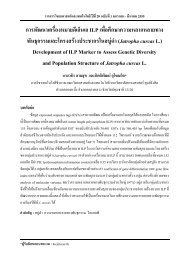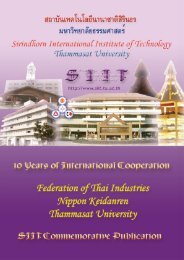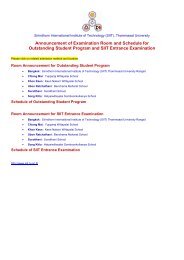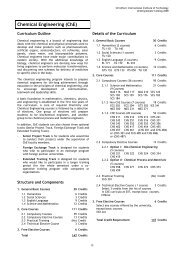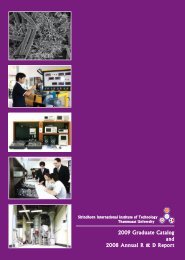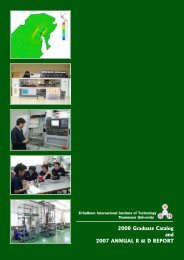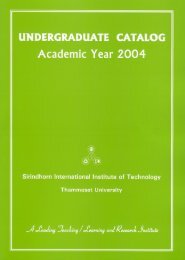2007 Graduate Catalog and 2006 Annual R & D Report - Sirindhorn ...
2007 Graduate Catalog and 2006 Annual R & D Report - Sirindhorn ...
2007 Graduate Catalog and 2006 Annual R & D Report - Sirindhorn ...
Create successful ePaper yourself
Turn your PDF publications into a flip-book with our unique Google optimized e-Paper software.
<strong>2007</strong> <strong>Graduate</strong> <strong>Catalog</strong> <strong>and</strong> <strong>2006</strong> <strong>Annual</strong> R & D <strong>Report</strong><br />
<strong>Sirindhorn</strong> International Institute of Technology (SIIT)<br />
School of Management Technology<br />
Faculty Members <strong>and</strong> Research Interests, <strong>2007</strong><br />
Dr. Chawalit Jeenanunta<br />
Lecturer<br />
B.S. in Computer Science, University of Maryl<strong>and</strong>, USA<br />
B.S. in Mathematics, University of Maryl<strong>and</strong>, USA<br />
M.S. in Management Science, University of Maryl<strong>and</strong>, USA<br />
Ph.D. in Industrial <strong>and</strong> Systems Engineering, Virginia Polytechnic Institute <strong>and</strong> State University, USA<br />
Research Areas: Linear programming, Integer programming, Network optimization, Simulation, Supply chain<br />
management.<br />
Research Interests:<br />
Large-Scale Simulation <strong>and</strong> Optimization<br />
Many problems in the real world are large <strong>and</strong><br />
complex. Researchers in this field are trying to<br />
improve the algorithm <strong>and</strong> utilize available<br />
computational technology such as parallelism or grid<br />
computing to solve such problems where their<br />
resulting models are also very large. This technology<br />
also enables researchers to have a detail model<br />
which is close to the real world problem. Some<br />
examples of these problems are transportation<br />
problem in the urban area (where there consists of<br />
millions of people driving on thous<strong>and</strong>s of streets),<br />
financial simulation, <strong>and</strong> bioinformatics.<br />
Supply Chain Management (SCM)<br />
The researches in SCM involve the study of the<br />
process of planning, implementing, <strong>and</strong> controlling the<br />
operations of the supply chain with the purpose of<br />
reducing cost <strong>and</strong> increasing efficiency. SCM includes<br />
all movement <strong>and</strong> storage of raw materials, work-inprocess<br />
inventory, <strong>and</strong> finished goods from origin to<br />
consumption. There are many problems that can be<br />
modeled by simulation <strong>and</strong> optimization models.<br />
Dr. Jittima Tongurai<br />
Lecturer<br />
B.B.A. in International Business Management, Assumption University, Thail<strong>and</strong><br />
B.Econ. in Monetary Economics, Ramkhamhaeng University, Thail<strong>and</strong><br />
M.Econ. in International Finance, Oita University, Oita, Japan<br />
Ph. D. of Commerce in Development Finance, Osaka City University, Osaka, Japan<br />
Areas of Specialization: Financial Institutions <strong>and</strong> Markets, Financial Liberalization, International Capital Flow,<br />
<strong>and</strong> Foreign Exchange.<br />
Research Interests:<br />
Asian Monetary <strong>and</strong> Financial Cooperation<br />
The 1997 Asian Crisis underscored the<br />
interdependence among Asian countries <strong>and</strong> the<br />
importance of regional cooperation in managing the<br />
challenges of globalization. Since the Asian Crisis,<br />
there have been moves to enhance monetary <strong>and</strong><br />
financial cooperation – especially among ASEAN+3<br />
countries (ASEAN countries, Japan, China, <strong>and</strong><br />
South Korea) – through information exchange <strong>and</strong><br />
policy dialogue, a regional liquidity support facility,<br />
<strong>and</strong> efforts to develop regional bond markets. The<br />
research focuses on cooperative efforts in the area of<br />
monetary policy <strong>and</strong> finance. It follows progress in<br />
monetary <strong>and</strong> financial integration in Asia, <strong>and</strong><br />
scrutinizes empirical evidence on monetary <strong>and</strong><br />
financial integration. It looks at key issues in limiting<br />
possible risks associated with regionalism <strong>and</strong><br />
possible ways in using integration as a way to reduce<br />
vulnerability to external shocks <strong>and</strong> financial<br />
contagion.<br />
International Capital Flow <strong>and</strong> Foreign Exchange<br />
The late 1980s marked the opening era of financial<br />
liberalization in developing economies. Capital<br />
Controls were abolished, <strong>and</strong> capital flowed freely<br />
across borders. On the one h<strong>and</strong>, this creates<br />
opportunities for developing countries to access<br />
international capital for their economic development.<br />
On the other h<strong>and</strong>, financial flows are volatile <strong>and</strong><br />
herd-like, bringing risks to those developing countries<br />
that overly borrow from the international capital<br />
market as witnessed in the 1982 Latin American Debt<br />
Crisis, the 1994 Mexican Crisis, the 1997-98 Asian<br />
Crisis, the 1998 Russian Crisis, <strong>and</strong> the 2001<br />
Argentinian Crisis. As the key determinant of foreign<br />
exchange rates has shifted away from trade flow to<br />
financial flow, foreign exchange markets are<br />
increasingly volatile. The research looks at evidence<br />
on capital account liberalization in developing<br />
countries, focusing on the relationship between<br />
international capital flow <strong>and</strong> foreign exchange<br />
28




